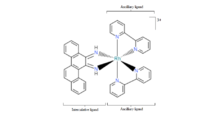DNA-binding metallo-intercalators are positively charged, planar, polycyclic, aromatic compounds that unwind the DNA double helix and insert themselves between DNA base pairs. Metallo-intercalators insert themselves between two intact base pairs without expelling or replacing the original nitrogenous bases; the hydrogen bonds between the nitrogenous bases at the site of intercalation remain unbroken. In addition to π-stacking between the aromatic regions of the intercalator and the nitrogenous bases of DNA, intercalation is stabilized by van der Waals, hydrophobic, electrostatic, and entropic interactions. This ability to bind to specific DNA base pairs allows for potential therapeutic applications of metallo-intercalators.
Synthesis of metallo-intercalators

In the case of ruthenium intercalators, the general synthesis consists of preparing intercalative ligands followed by their coupling to a ruthenium metal complex coordinated by specific ancillary ligands. Examples of prior ruthenium complexes used as precursors for metallo-intercalators include cis- and cis-∙2H2O, which can be synthesized into , , (ClO4)2, and Ru(phen)2(bfipH)](ClO4)2.
Mechanism of DNA-intercalation

Metallo-intercalators π-stack with unbroken DNA base pairs after entering via a groove, typically the major, (in contrast to metallo-insertors, which replace expelled base pairs after entering double stranded DNA via the minor groove). Intercalation of a metallo-intercalator creates less strain in the DNA duplex than insertion; metallo-insertors induce an untwist of the double helix and an opening of the phosphate backbone while metallo-intercalators marginally increase the rise and width of the major groove. Intercalation of metal compounds between DNA base pairs effectively stabilizes the double helix, increasing the melting temperature of the DNA duplex. Binding of metallo-intercalators to DNA is reversible and depends on the properties of the intercalating molecule. Metallo-intercalators with different metal centers, oxidation states, coordination geometries, and overall sizes will exhibit varying “depths of insertion”. For example, square planar complexes penetrate deeper into the DNA base pairs than octahedral or tetrahedral complexes do. Also, positive charges on the metallo-intercalator strengthen DNA-binding because of electrostatic attraction to the negatively charged sugar-phosphate backbone.
Therapeutic applications

Metallo-intercalators have a variety of potential therapeutic applications as a result of their structural diversity and universal photooxidative properties. One possible therapeutic application of metallo-intercalators is to combat cancerous tumor cells within the body by targeting specific mismatched DNA base pairs; the ability to modify the ligands bound to the metal center allows for a high degree of specificity in the binding interactions between the metallo-intercalator and the DNA sequence. For example, the ligand 5,6-chrysenequinone diimine (chrysi) and its analogues are designed to be too wide to fit inside the normal span of the base pairs of B-DNA, causing it to bind instead to the wider portions of the helix at destabilized sites of mismatched bases. After intercalation, the sample can be photoactivated by absorbing energy during irradiation with short wavelength light. This activation causes the metallo-intercalator's photooxidative properties to induce a cleavage of the sugar phosphate backbone at the site of mismatch through a radical mechanism. Even in the absence of irradiation, the interactions between the metallo-intercalator and DNA can substantially decrease the proliferation of cells containing DNA with mismatched base pairs.
References
- ^ Zeglis, Brian M.; Pierre, Valerie C.; Barton, Jacqueline K. (2007). "Metallo-intercalators and Metallo-insertors" (PDF). Chemical Communications. 44 (44): 4565–79. doi:10.1039/b710949k. PMC 2790054. PMID 17989802.
- ^ Gill, Martin R., and Jim A. Thomas. "Ruthenium(ii) Polypyridyl Complexes and DNA-from Structural Probes to Cellular Imaging and Therapeutics - (RSC Publishing)." Chem Soc Rev, n.d. Web. 26 Jan. 2015. <http://pubs.rsc.org/en/Content/ArticlePDF/2012/CS/c2cs15299a>.
- ^ Pages, Benjamin J., Dale L. Ang, Elise P. Wright, and Janice R. Aldrich-Wright. "Metal Complex Interactions with DNA." Royal Society of Chemistry, n.d. Web. 26 Jan. 2015. <http://pubs.rsc.org/en/content/articlehtml/2014/dt/c4dt02700k>.
- ^ Vargiu, Attilio V., and Alessandra Magistrato. "Detecting DNA Mismatches with Metallo-Insertors: A Molecular Simulation Study." Inorganic Chemistry. Inorganic Chemistry, n.d. Web. 26 Jan. 2015. <http://pubs.acs.org/doi/pdfplus/10.1021/ic201659v>.
- ^ Raman, Natarajan; Rajakumar, Ramasubbu (2014). "Bis-amide Transition Metal Complexes: Isomerism and DNA Interaction Study". Spectrochimica Acta Part A: Molecular and Biomolecular Spectroscopy. 120: 428–436. doi:10.1016/j.saa.2013.10.037. PMID 24211801.
- ^ Liu, Yun-Jun; Liang, Zhen-Hua; Li, Zheng-Zheng; Yao, Jun-Hua; Huang, Hong-Liang (2011). "Ruthenium(II) Polypyridyl Complexes: Synthesis and Studies of DNA Binding, Photocleavage, Cytotoxicity, Apoptosis, Cellular Uptake, and Antioxidant Activity". DNA and Cell Biology. 30 (2): 829–38. doi:10.1016/j.ejmech.2009.10.043. PMID 19932529.
- Du, Ke-Jie, Jin-Quan Wang, Jun-Feng Kou, Guan-Ying Li, Li-Li Wang, Hui Chao, and Liang-
- ^ Kielkopf, C. L., K. E. Erkkila, B. P. Hudson, J. K. Barton, and D. C. Rees. "INTERCALATION AND MAJOR GROOVE RECOGNITION IN THE 1.2 A RESOLUTION CRYSTAL STRUCTURE OF RHPHI BOUND TO 5'-G(5IU)TGCAAC-3'" RCSB Protein Data Bank. N.p., n.d. Web. 26 Jan. 2015. <http://www.rcsb.org/pdb/explore/explore.do?structureId=454D>.
- ^ Lauria, Antonino, Riccardo Bonsignore, and Alessio Terenzi. "Nickel(ii), Copper(ii) and Zinc(ii) Metallo-intercalators: Structural Details of the DNA-binding by a Combined Experimental and Computational Investigation - (RSC Publishing)." Royal Society of Chemistry, n.d. Web. 26 Jan. 2015. <http://pubs.rsc.org/EN/content/articlehtml/2014/dt/c3dt53066c>.
- Alessandro Biancardi, Azzurra Burgalassi, Alessio Terenzi, Angelo Spinello, Giampaolo Barone, Tarita Biver, and Benedetta Mennucci. |title="A Theoretical and Experimental Investigation of the Spectroscopic Properties of a DNA‐Intercalator Salphen‐Type ZnII Complex" |journal=Chemistry–A European Journal, |date=2015 |volume=20 |issue=24 |pages=7439-7447. |doi=10.1002/chem.201304876
- ^ Pierre, VC; Kaiser, JT; Barton, JK (2007). "Insights into finding a mismatch through the structure of a mispaired DNA bound by a rhodium intercalator". Proc. Natl. Acad. Sci. U.S.A. 104 (2): 429–34. Bibcode:2007PNAS..104..429P. doi:10.1073/pnas.0610170104. PMC 1766401. PMID 17194756.
- ^ Junicke, H.; Hart, J. R.; Kisko, J.; Glebov, O.; Kirsch, I. R.; Barton, J. K. (2003). "Bioinorganic Chemistry Special Feature: A Rhodium(III) Complex for High-affinity DNA Base-pair Mismatch Recognition". Proceedings of the National Academy of Sciences. 100 (7): 3737–42. Bibcode:2003PNAS..100.3737J. doi:10.1073/pnas.0537194100. PMC 152991. PMID 12610209.
- ^ Hart, J. R.; Glebov, O.; Ernst, R. J.; Kirsch, I. R.; Barton, J. K. (2006). "DNA Mismatch-specific Targeting and Hypersensitivity of Mismatch-repair-deficient Cells to Bulky Rhodium(III) Intercalators". Proceedings of the National Academy of Sciences. 103 (42): 15359–5363. Bibcode:2006PNAS..10315359H. doi:10.1073/pnas.0607576103. PMC 1622828. PMID 17030786.